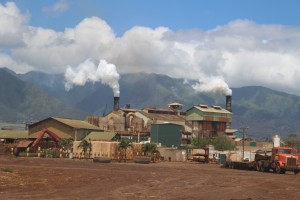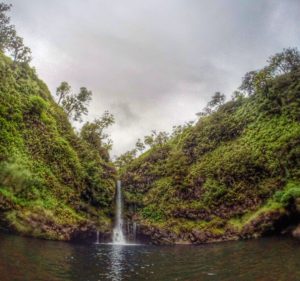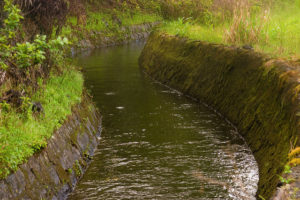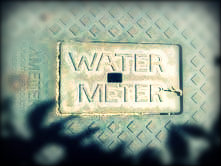The Battle for Water Continues in East Maui
The State Commission on Water Resource Management heard final arguments on a petition to establish minimum flow standards for more than 20 streams diverted by Alexander & Baldwin subsidiary East Maui Irrigation.
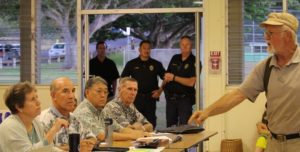
A man speaks out towards the commission during Monday evenings hearing at Haiku Community Center. He was escorted out of the building shortly after by DLNR. PC: Nikki Schenfeld
A standing-room-only crowd was in attendance at the Haʻikū Community Center Monday evening, Oct. 9, 2017, many wearing blue shirts in support of East Maui kalo farmers, residents and East Maui streams.
No public testimony was allowed; therefore, members of the community who did speak out were escorted out of the building by state Department of Land and Natural Resources officials.
The battle, considered to be one of the largest water rights cases in the state, has been ongoing for 16 years.
The contested case is the result of a petition filed by Maui Tomorrow and the Native Hawaiian Legal Corporation, on behalf of Nā Moku Aupuni o Ko‘olau, a community of taro farmers, fishermen, hunters and traditional practitioners.
Advocates of the release of water say the diversion is affecting streams, aquatic habitat, aquifers, nearshore fisheries and Native Hawaiian cultural practices, such as kalo farming, gathering and access to mauka to makai stream flow.
On the opposing side, A&B says that although it has ceased sugarcane production, it still needs significant amounts of water for it’s diversified agriculture plan for Central Maui.
First speaker: Native Hawaiian Legal Corp. on behalf of Na Moku Aupuni o Ko‘olau
Summer Sylva of Native Hawaiian Legal Corp. spoke on behalf of Na Moku Aupuni o Ko‘olau.
Sylva said petitions were first filed back in 2001 to increase the instream flow standards (IIFS) for 27 East Maui streams from 1988 status quo levels.
“Just like in 1988, leftover flows from Hawaiian Commercial and Sugar Company’s existing diversions is still all the water that 10 of the 27 petitioned streams will be afforded,” said Sylva.
She said of the 10 streams, HC&S present and future irrigation requirements, up to the amount diverted in 1988 when sugar was king, will dictate and take priority over those streams.
She said the levels back then were intended to maintain East Maui Irrigation’s century-old diversions at all times, which provided all the water needed for the sugar company’s 30,000 acres in Central Maui.
“To be clear, sugar got was sugar needed, HC&S got what HC&S needed and the streams that supplied all those needs got their leftovers—if any,” she said.
She added that the petitions that were filed were never solely about taro farming.
“The fact that only six of the 27 streams currently feed taro loʻi puts that myth to rest,” said Sylva.
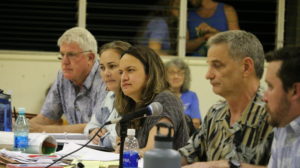
From L-R: Isaac Hall on behalf of Maui Tomorrow, NHLC representative, Summer Sylva on behalf of Na Moku, and A&B and EMI attorney David Schulmeister. PC: Nikki Schenfeld
She said the taro farmers are also hunters, fishers, gatherers, recreational users, admirers and stewards of the entire East Maui Hāmākua Ko‘olau region.
“They filed these petitions on behalf of all these protected instream uses and all life supported by and depended on this regions bounty,” she said.
Sylva noted that 36 streams traverse the license areas and six more streams, totaling 42, flow over areas where EMI and Maui County ditches divert stream flows.
She said of the 42 streams, Nā Moku petitioned to amend the IIFS for 24 of them.
“That means—and this is crucial—18 non-petitioned streams have always been and continue to be available to HC&S and EMI to divert without limit, without interruption and without regulation under the EMI existing ditch system.”
Of the 24 petitioned streams, EMI and Maui County divert 22 of them.
EMI is the oldest subsidiary of A&B and the County of Maui relies on A&B’s supply of public water.
Some residents worry that if A&B or a new owner decided to no longer deliver water to the Upcountry water system, then the county wouldn’t be able to provide water to Upcountry residents.
“The irony, the tragedy, really, is that even though the the days of sugar are long over, it’s stranglehold on the flows of these 28 streams will persist if you do nothing affirmative to protect them,” she told the commission.
Sylva mentioned a letter written by the county Department of Aquatic Resources to the commission on Dec. 15, 2009. The letter stated, “The return of 100% of diverted water and elimination of diverted structures would be the most desirable IIFS for protection and management of native stream animals.”
Sylva said that at the time of the statement, sugar was king and the thirstiest crop. The actual average of surface water deliveries was 126 million gallons a day, and that total reasonable beneficial uses for HC&S and Maui County, combined with their losses, was 188.9 mgd.
With sugar gone, Sylva says the actual surface water deliveries needed to meet HC&S and Maui County needs are presently 20 mgd to irrigate 680 acres in cultivation of test crops and to supply all Upcountry users with water it needs.
“That is a stark contrast from 126 mgd for 29,000 acres actively in cultivation a few years back,” she said.
When A&B announced it was closing HC&S sugarcane plantation in December 2016, it said it would transition the former cane fields to diversified agriculture. HC&S submitted an agriculture plan to the commission that included dairy operations, bioenergy crops, ag parks and small farms. According to HC&S, total estimated surface water needs post-sugar would amount to nearly 115 million gallons a day.
“By year’s end, at most, 5,000 additional acres are forecasted to be in cultivation in diversified agriculture, but no timeline exists for the 21,300 remaining acres forecasted for diversified agriculture,” she said.
In August, a hearing officer in the contested case proceeding recommended restoring 26.5 mgd to 12 streams diverted by A&B.
The proposed decision set maximum water requirements at 83.75 mgd for A&B’s diversified agricultural program on 27,000 acres and 16 mgd for the county for domestic and agricultural uses.
“It’s important to note that in 2010, this hearing officer, a commissioner like you in these very proceedings, said, ‘I think, legally, we’re supposed to restore all the streams at the minimum at the H90 flow level,'” Sylva pointed out, “The same holds true now.”
Second speaker: Maui Tomorrow Attorney Isaac Hall
“This commission has the authority today to adopt modify, or reject this report,” said Hall. “Because you are the trustees of our public stream resources, we believe it’s as clear as a free-flowing East Maui stream, that you have only two choices; to reject the report as a whole or seriously modify the report to bring it into compliance with the law.”
Since the shutdown of HC&S in December 2016, A&B and EMI have continued to divert water from East Maui under a holdover permit issued by the state Board of Land and Natural Resources. In approving the holdover, the BLNR added some stipulations but did not indicate how the water would be monitored or enforced.
Hall said that EMI ditch systems were designed for monitoring at the edge of each licensed area to decide how much EMI and HC&S should pay for the water it’s getting.
“For a very long time, the amount that exist above each diversion is unknown and still unknown, the amount diverted from each stream is unknown still, and the amount that exists below each stream has never been documented either,” he said. “We don’t have this vital information needed for an IIFS proceeding. Your regulations have required the assembly of that data since 1988.”
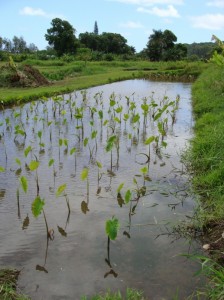
E. Maui farmers urged to submit survey that could have impact on future instream flow standards. Photo of Keanae Loi by Wendy Osher 2009)
On April 20, 2016, A&B agreed to “fully and permanently” restore stream flows to seven East Maui taro streams. Hall said the commission issued its order of interim restoration of stream flow on July 18, when they said they understood the urgency to restore stream flow to the streams to provide connectivity mauka to makai as soon as possible.
Hall said EMI had the right to file an application and doesn’t believe one has been completed. He said EMI is “dragging its feet,” and that the state hasn’t pushed EMI to get the application going even though the commission expressed urgency in July.
“We’re the ones getting prejudice by the lack of enforcement because the downstream users don’t get the “fully and permanently” restored streams and EMI gets to continue to divert the water and HC&S and the County get to use that water, this is not fair,” he said.
“EMI obviously has a conflict of interest and I’m going to ask you to hire someone else to process the application that doesn’t have a conflict of interest and EMI can pay for the processing of that application,” Hall added.
In response to A&B’s post-sugar agriculture plan, Hall said that A&B will lease the land to unknown private commercial lessees.
“The water is now for unknown commercial lessees of A&B,” Hall said. “A&B calculated its water demand by multiplying the agriculture water need by the total number of acres, which was objected to by the Hawai‘i Supreme Court.”
He added, “When you have testimony that no one is going to begin cultivation within 20 years of that finding, I think, is a gross over-allocation of water, far exceeding actual need in violation of the public trust doctrine.”
The Hawaiʻi State Constitution’s public trust doctrine states:
“For the benefit of present and future generations, the state and its political subdivisions shall conserve and protect Hawaiʻi’s natural beauty and all natural resources, including land, water, air, minerals and energy sources, and shall promote the development and utilization of these resources in a manner consistent with their conservation and in furtherance of the self-sufficiency of the state.
All public natural resources are held in trust by the state for the benefit of the people.”
Hall noted an instance regarding a taro farmer saying the commission knew that the IIFS were not being met and that EMI said they wanted to close the gates so they could get more water.
“Your staff member exceeded to that request of EMI and lowered the gates further so now this taro grower can’t even grow taro,” Hall said.
“Asking someone to grow taro without water is like asking someone to drive a car without any gas—you can’t do it,” Hall added.
Regarding the hearing officer’s findings, Hall said there are no determinations to prove that the county needs 16 mgd and that the hearing officer “forgot to include” the county already has access to 7.6 mgd from other sources including 4.2 mgd from upper and lower Waikamoi and 3.4 mgd from wells, totaling 23.6 mgd.
Hall agreed with Sylva in regard to the 18 streams free for use that aren’t being petitioned.
According to the hearing officer’s report, Hall said that 8.5 mgd were available in additional streams between Honopou and Maliko and that there’s 12 non-petitioned streams in the Huelo lease.
“Maybe you’re not charging the county, EMI, HC&S and A&B enough money for the water,” Hall suggested to the commission. “They should be having to pay money sufficient so you can perform the functions you’re required to by your regulations so those taro growers and those downstream users aren’t hurt by the lack of monitoring and lack of enforcement.”
Hall suggested a solution of the possibility of having a review every three years in which anyone could come in, lessee or taro grower, to get more water and not just A&B lessees.
Third speaker: David Schulmeister, attorney for EMI and A&B
As Schulmeister approached the microphone, a man interrupted and slammed a book onto the commission’s desk, saying they need to… [deleted] and that they are in violation of the doctrine. He was quickly escorted out.
Schulmeister agreed with the proposed decision by the hearing officer, saying it was a reasonable recommendation and that it “deserves a chance to see how it’s going to work in practice.”
He noted that Sylva mentioning the petition wasn’t solely about taro farming, “is pretty much an admission the taro streams are being taken care of with this proposed decision.” He said the proposed decision acknowledges the restoration of the taro feeding streams.
Schulmeister said A&B had committed to restore more than what the hearing officer recommended and that A&B included Piʻinaʻau stream in one of the streams that would no longer be diverted—which wasn’t one of those included in the hearing officer’s recommendations.
“We didn’t agree on Makapīpī stream, but looking at larger picture, A&B believes overall reasonable balance was struck and we need to move forward, and we need to have an IIFS decision,” Schulmeister said.
Schulmeister said Maui Tomorrow Executive Director Albert Perez testified that the group wanted to see diversified agriculture in Central Maui.
“Sometimes it’s difficult to reconcile some of the testimony and statements they make with some of the arguments they make at times like this,” Schulmeister said. “Perez said Maui Tomorrow supports diversified agriculture in Central Maui and supports the use of imported surface water from East Maui for diversified agriculture, so it comes down to how the balance is struck.”
Regarding the proposed plans for Central Maui in response to Hall’s testimony, Schulmeister said, “It’s difficult to find new uses for the number of acres we’re talking about… HC&S has not gone out of existence; it was always a division of A&B.”
Schulmeister said Rick Volner, general manager of diversified agriculture for A&B, submitted evidence of what the plan was and what the forecasted needs are. He said the situation is a catch-22, “when you’re trying to interest potential lessees to do farming in these acres they want to know what the source of water will be.” He added, “While petitioners say, ‘let’s just put all the water that’s required to be left in the streams and later when someone has invested the money,’ it’s not feasible.”
Schulmeister said what needs to happen is what the hearing officer proposed. He said the officer considered forecasts and evidence and that the type of plant for each crop was analyzed, including rainfall amounts, which were all worked into a model.
He said A&B and HC&S is committed to try and pursue the diversified ag plan and that progress has already been made but it’s difficult to have a timeline when there is no IIFS decision that states the potential surface water that’s going to be available for agriculture.
“When the plantation shut down, the demand for water dropped to close to nothing,” he said. “We still had to supply the County of Maui and have a minimum level for reservoirs and some activities. So, currently 20 mgd is cutting in through the ditch system is adequate for what’s going on right now.”
One resident interrupted, saying, “I don’t think you heard the question. The question is, how much water do you have other than that? That is the whole question.” (see below video)
He was then escorted out by DLNR officials.
Schulmeister then began talking about the pump system, saying the amount of water being imported is sufficient because the water that goes to the county is surface water and a relatively small amount is being imported to HC&S right now. He said the pumps aren’t being used right now because there’s enough water at the moment and it’s less than the interim order requires, as long as there’s some rain.
“For sugar, the pumping averaged 70 mgd, there were times it was much more than that,” he said. “During dry times, lower fields would go days, even weeks getting brackish water.”
“Of the 70 mgd historically pumped from your wells, what percent of that was a result of offstream recharge of the East Maui streams?” one of the commission members asked Schulmeister.
Schulmeister responded, “I don’t think that’s an answerable question.”
The same commission member said, “One of the issues is a pretty wide disparity of opinion. How much water could you pump from your wells? I think the hearing officer had 0 to 20 mgd and your saying, historically you pump up to 70 mgd. Are we to say the 50 mgd came from East Maui streams or is 20 mgd too low an estimate for what you can pump under groundwater?”
Schulmeister said, “The thing you have to keep in mind is, the pumps can pump the water. The question is going to be, how salty is the water?”
He said the hearing officer found the pumps could handle up to 80 to 120 mgd without causing the capitation of the pump, but then the quality of water (if the pumps are run at that level) would lead to the rise of chlorides and that when chlorides rise, there’s a problem with the soil.
The commission double-checked his numbers and said to Schumeister, “You said 70 to 80 mgd and the hearing officer is allotting about 20 mgd from your pumps—that’s what I’m reading. I’m just trying to chase those other 50 mgd.”
Schulmeister explained that sugarcane was tolerant of brackish water, more so than any other crops. He said the plan with diversified ag is dealing with more sensitive crops that are less salt tolerant.
Fourth speaker: Maui County Department of Water Supply
Caleb Rowe on behalf of Maui County Department of Water Supply said the county agreed with the hearing officer’s findings as well.
He stated the county supplies water to 35,000 Upcountry residents and that the water is used for agriculture and domestic purposes, as well as the public health and safety and for fire prevention.
The DWS estimates the Upcountry population to grow to 44,000 by 2030, and the water is needed for families, businesses, schools, government facilities and several acres of agricultural land at Kula Ag park.
He also mentioned the decade-old wait list for new water meters and that there are currently about 1,800 people on the wait list.
“In these proceedings, the DWS sought enough water to accommodate its current needs and future needs based on projected population growth and unmet needs reflected by the Upcountry wait list,” Rowe said. “The proposed laws issued by the hearing officer recognized the county’s current needs and projections, and for this reason, the County of Maui agrees with hearing officer’s findings.”
He said the needs of the County of Maui are directly related to consumer use, and that if the population doesn’t grow as projected, then the county won’t use the water.
Rowe was asked by the commission what the existing demand is from the County, he said the maximum is about 16 mgd. When asked what the existing need for consumption uses was, he replied, “It fluctuates 6 to 8 mgd… the average is 7.1 mgd, I believe.”
The commission will start weighing the arguments; there is no timeline yet for their decision.
Below, an interview with Lurlyn Scott, a taro grower and plaintiff in the contested hearing case.
The original petition included review of flow standards at the following East Maui streams: Honopou, Hanehoi/Puolua, Waikamoi, Alo, Wahinepeʻe, Puohokamoa, Haipuaʻena, Punalau/Kolea, Honomanū, Nuaʻailua, Piʻinaʻau, Palauhulu, ʻŌhiʻa (Waianu), Waiokamilo, Kualani (Hamau), Wailuanui, Waikani, West Wailuaiki, East Wailuaiki, Kopiliula, Puaʻakaʻa, Waiohue, Paʻakea, Waiaaka, Kapaula, Hanawī and Makapīpī.



